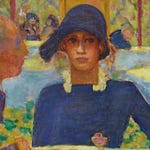Dolce Far Niente
Are we the last to notice the assimilationist trend among ethnic restaurants? In the days of our youth, we could tell one from another. Crystal, white linen, supercilious maître d’ — it’s French, naturellement; red and gold — Chinese; downstairs — Indian; and so on. In this orderly scheme, Italian restaurants generally projected a working-class or peasant image. We could count on candles in chianti bottles; huge, cheap meals of pasta and tomato sauce; lots of garlic; fat loaves of bread; simple, zesty food in Breughelesque settings. Tuck the napkin into your shirt collar, talk loud, bring the whole family, let the kids run around, and give them a good smack if they get out of line. Now — all, all is changed. In the last year we have dined in an Indian restaurant that looks like a wood-and-white fern bar, a Chinese restaurant that looks like an art-deco lounge on the Normandie, a French restaurant with hatch-cover tables and exposed brick, and no fewer than four restaurants in which the walls are paneled with ash, there is a brass railing in every spot where there might conceivably be a brass railing, and everything is bright, light, and shining, including the diners, who are well scrubbed and blond. One of these ash-and-brasseries is Thai, one Italian, one Nouvelle melting-pot, and one Indian. What’s happening here? Is the tendency toward an American mush so advanced that not even the newest immigrants retain or want to retain any of their home-country stereotypes? Whew! Excuse us. We may have gotten a little carried away.
Dolce Far Niente is an example of a kind of ethnic restaurant that has sprung up in the last couple of years; it turns its back on moldy old-fashioned ethnic stereotypes and embraces fresh new ideas. In this case, the dominant idea seems to be that nothing in the décor should suggest that the place serves Italian food, or that it serves food at all. It is turned out in some damned style or other, but since we are a mere food critic we are unable to say just what style it is. It is one of those styles that know no boundaries, within which tin is as good as gold — l’esthétique du mal, perhaps, or langue-en-joue. For all we know, it may be International, or postmodern, or neo-something, or retro–something else. Whatever it is, it includes jokes: a safe tipped on one corner, artfully peeling plaster, and trompe l’oeil water stains. One literal-minded diner within our eavesdropping range, recognizing how much effort had gone into making this place look like the aftermath of a disaster, announced, “I’ll have the crust of bread and the day-old water,” expecting, no doubt, that disaster décor called for mission cuisine.
[to be continued]
Have you missed an episode or two or several?
You can begin reading at the beginning or you can catch up by visiting the archive or consulting the index to the Topical Guide.
You can listen to the episodes on the Personal History podcast. Begin at the beginning or scroll through the episodes to find what you’ve missed.
You can listen to “My Mother Takes a Tumble” and “Do Clams Bite?” complete and uninterrupted as audiobooks through YouTube.
You can ensure that you never miss a future issue by getting a free subscription. (You can help support the work by choosing a paid subscription instead.)
At Apple Books you can download free eBooks of Little Follies and Herb ’n’ Lorna.
You’ll find overviews of the entire work in An Introduction to The Personal History, Adventures, Experiences & Observations of Peter Leroy (a pdf document) and at Encyclopedia.com.













